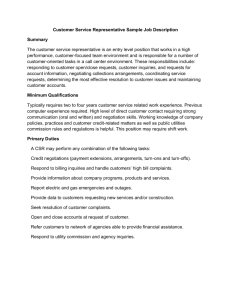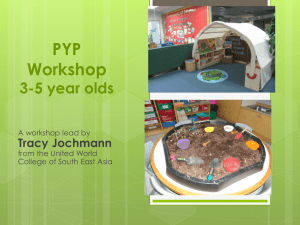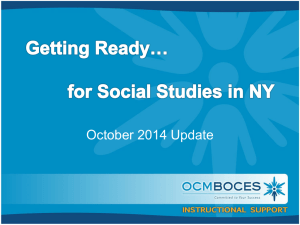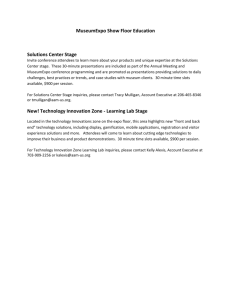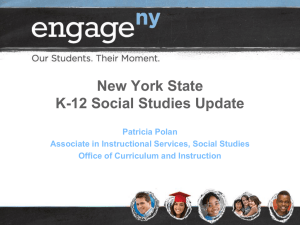Social studies in the 21st century - Center for Instruction, Technology
advertisement
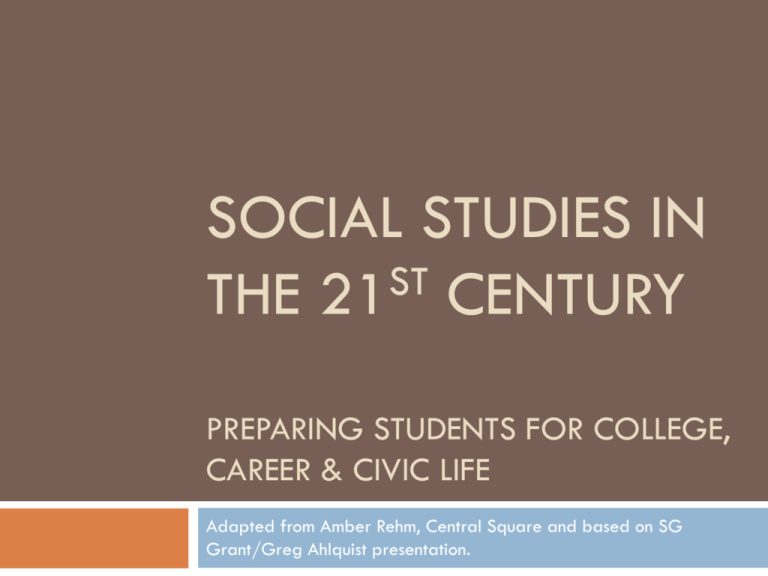
SOCIAL STUDIES IN ST THE 21 CENTURY PREPARING STUDENTS FOR COLLEGE, CAREER & CIVIC LIFE Adapted from Amber Rehm, Central Square and based on SG Grant/Greg Ahlquist presentation. Social Studies on the Rebound Despite seeming to be left behind in recent years, state and national efforts on behalf of social studies are emerging and changes are in the works College, Career, and Civic Life (C3) Framework for Social Studies State Standards (NCSS - 2013) New York State K-12 Social Studies Framework (Adopted April 2014) New York State K-12 Social Studies Resource Toolkit and Professional Development Project (Projected publication – August 2015) A Program that Supports Teaching, Learning & Assessment These components work interdependently in both instruction and assessment. Through an inquiry-based approach, students develop thematic and conceptual understanding while applying disciplinary practices and literacy skills in the context of content. Pedagogy Behind the C3 Social Studies Framework: The Inquiry Arc Dimension 1: Developing Questions and Planning Inquiries Dimension 2: Applying Disciplinary Concepts and Tools (Civics, Economics, Geography, and History) Dimension 3: Evaluating Sources and Using Evidence Dimension 4: Communicating Conclusions and Taking Action NY Social Studies Framework 3 Instructional Shifts Focus on Conceptual Understanding Rather than facts, breadth of topics, and recall Foster Student Inquiry, Collaboration, and Informed Action Rather than teacher as disseminator, students who learn facts from textbooks, students that retell interpretations Integrate Content and Skills Purposefully Rather than students focusing solely on content knowledge or developing literacy skills and social studies practices separately Social Studies Framework Explained Key Ideas Conceptual understandings Content Specifications Key Ideas: big, overarching ideas that provide context and structure for students’ learning. Conceptual Understandings: provide more specific and detailed information that support the Key Idea. Content Specifications: written as “Students will…” statements, outline the specific content that can be taught to illustrate the Conceptual Understanding and support the larger Key Ideas. Example from SS Framework: 3rd Grade 3.1 Geographic regions have unifying characteristics and can be studied using a variety of tools. (Key Idea) 3.1a Earth is comprised of water and large land masses that can be divided into distinct regions. (Conceptual Understanding) Students will identify the continents and oceans, by using globes and maps. Students will locate the selected world communities in relation to oceans and continents. (Content Specifications) Common Core Skills Embedded in SS Common Core ELA is necessary but not sufficient Reading Writing Key Ideas and Details Craft and Structure Integration of Knowledge and Ideas Range of Reading & Text Complexity Text Types and Purposes Production and Distribution of Writing Research to Build and Present Knowledge Range of Writing Speaking and Listening Comprehension and Collaboration Presentation of Knowledge and Ideas Social Studies Toolkit Project Timeline Field Guide Published (Fall 2014) – “almost obsolete” Refining, reviewing, piloting and revising inquiries and conceptual foundations (Aug. 2014 – Aug. 2015) 14 Annotated Inquiries (1 for each grade level; 2 for 12th; first 3 to be released at end of Feb. 2015) 70 Abridged Inquiries (5 per grade level) 84 Total Inquiries (6 Inquiries per grade level ) Developing additional annotated and abridged Inquiries; piloting inquiries (Nov. – Feb. 2015) Revising annotated inquiries (March – May 2015) Publishing of Social Studies Toolkit (August 2015) The intention of the Toolkit is to bridge the NY State Framework for Social Studies and teachers’ classroom practice. Why Inquiries Rather Than Units? Inquiries are not fully-developed content units or modules, require teachers to supplement with other sources and activities Written by teachers and piloted by teachers Inquiries enable pedagogical coherence not scripts An inquiry need not necessarily cover an entire key idea A Key Idea may necessitate several inquiries Compelling questions are intellectually meaty and kid friendly Teachers have freedom to choose some supporting questions and sources and not others Teacher expertise and agency is key What will the Inquiries look like? What will the Inquiries look like? What Does Taking Informed Action Mean? Understand the problem Assess options for action Research issue relevant to inquiry Identifying the problem(s) and possible civic action(s), brainstorming a list of opportunities and constraints Apply and take action: Civic Activism Organizing a boycott, petition, fundraiser, school newspaper editorial, school assembly, bringing stakeholders together for a classroom forum, class presentation, work in the community to solve problems New Social Studies Assessments Global History & Geography Regents - June 2018 (current 7th graders) Exam will only over modern world history 1750 to present Students will need a good foundation in Global 9 in order to do well United States History Regents – June 2019 Implications of 4+1 Pathway to Graduation First time that the Office of Assessment is working together with teachers to create these new exams (content & skill) What will these new exams look like? Evidence Centered Design (ECD): Testing skills and content together Multiple-choice (stimulus style NOT jeopardy style) Shorter Constructed Response Questions A set of questions based on a stimulus Must bring in content knowledge, use and understand the stimulus to then answer a set of questions Often based on stimulus as well Students have to understand stimulus or question and then pull from their knowledge Example: “Give 1 piece of evidence that would support the author’s argument and give 2 pieces that would refute.” Document Based Question (become more like AP style) Example of MC Stimulus Question from AP United States History Exam This excerpt is taken from journalist John L. O’Sullivan’s 1845 essay “Annexation,” in which he first used the phrase “manifest destiny.” The concepts of Manifest Destiny and expansionism are addressed in learning objectives ID-2 and WOR-6. Questions 9–11 refer to the following quotation. “Our … destiny [is] to overspread the continent allotted by Providence for the free development of our yearly multiplying millions. . . . The Anglo-Saxon foot is already on [California’s] borders. Already the advance guard of the irresistible army of Anglo-Saxon emigration has begun to pour down upon it, armed with the [plow] and the rifle, and marking its trail with schools and colleges, courts and representative halls, mills and meetinghouses. A population will soon be in actual occupation of California. . . . Their right to independence will be the natural right of self-government belonging to any community strong enough to maintain it.” — John L. O’Sullivan, 1845 9. 9. The ideas expressed in the passage above most clearly show the influence of which of the following? (A) Models of limited government inherent in the Articles of Confederation (B) Beliefs in separation of powers articulated in the United States Constitution (C) Concerns about foreign alliances expressed in George Washington’s Farewell Address (D) Concepts of republican democracy found in the Declaration of Independence Example of Stimulus Question from AP United States History Exam Continued... 10. The process described in the passage above most directly led to political controversies in the 1840s and 1850s over the (A) expansion of slavery into newly acquired territories (B) authority of the Supreme Court to overturn federal laws (C) role of the federal government in economic development (D) use of natural resources in newly acquired territories 11. Which of the following events in the late 19th and early 20th centuries represents a continuation of the process described in the passage above? (A) Efforts to restrict immigration to the United States (B) The Supreme Court’s endorsement of racial segregation (C) The United States gaining possession of overseas territories (D) Political parties’ attempts to regulate economic activities Example of Sample Short Answer Constructed Response Question United States historians have proposed various events to mark the beginning of an American identity. A) Choose ONE of the events listed below, and explain why your choice best represents the beginning of an American identity. Provide at least ONE piece of evidence to support your explanation. End of the Seven Years’ War (French and Indian War) in 1763 Signing of the Declaration of Independence in 1776 Ratification of the United States Constitution in 1788 B) Contrast your choice against ONE of the other options, demonstrating why that option is not as good as your choice. Social Studies in the st 21 Century Focus on Continuity: With all of these changes, what remains the same? NY State Social Studies Standards Standard 1: History of the United States and New York Standard 2: World History Standard 3: Geography Standard 4: Economics Standard 5: Civics, Citizenship, and Government Social Studies Practices or Historical Thinking Skills (K-12) Gathering, Using, and Interpreting Evidence Chronological Reasoning and Causation Comparison and Contextualization Geographic Reasoning Economics and Economics Systems Civic Participation 10 Unifying Themes of Social Studies Culture Time, Continuity and Change People, Places and Environments Individual Development and Identity Individuals, Groups and Institutions Power, Authority and Governance Production, Distribution and Consumption Science, Technology and Society Global Connections Civic Ideals and Practices Social Studies Content Sequence Grade and Content Focus Kindergarten: Self and Others Grade 1: My Family and Other Families, Now and Long Ago Grade 2: My Community and Other United States Communities Grade 3: Communities around the World Grade 4: Local History and Local Government Grade 5: The Western Hemisphere Grade 6: The Eastern Hemisphere Grade 7: History of the United States and New York – I Grade 8: History of the United States and New York – II Grade 9: Global History and Geography – I Grade 10: Global History and Geography – II Grade 11: United States History and Government Grade 12: Participation in Government & Economics, the Enterprise System, and Finance Compelling Questions for Elementary Teachers and the Social Studies Where does Social Studies fit into the elementary schedule? (Daily? Weekly? Monthly?) What are the connections between the ELA modules that are rooted in Social Studies and the Social Studies Framework? How will the inquiries from the SS Toolkit help to bring the SS Framework into classroom practice? What can we use or create that would enable Social Studies to come back into the elementary classroom? Advice from Social Studies Experts Elementary teachers are crucial to helping students prepare for the new Social Studies exams; but more importantly to preparing students for civic life Begin to have vertical conversations; vertical spiraling of skills and content from elementary, middle school and high school Make reasonable shifts because of the time allotment in elementary schedule 2015 is a year of learning, make small changes or shifts to instruction and lessons Request professional development opportunities from district administration Thank you For more information: • E-mail Liane Benedict at lbenedict@oswegoboces.org or Barb Recchio at brecchiodemmin@oswegoboces.org • Visit the following websites • • http://www.c3teachers.org/ https://www.engageny.org/resource/new-york-state-k-12social-studies-framework
